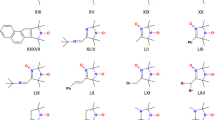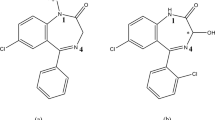Abstract.
The electronic structure of diazepam was analyzed by pulsed 14N nuclear quadrupole resonance (NQR) spectroscopy and density functional theory (DFT) calculations using the hybrid method B3PW91 with the 6-31G(d,p) basis set. Before searching for 14N NQR spectra, a 35Cl NQR line in diazepam was recorded to evaluate the degree of disorder in the crystal lattice and thus the chances to find much weaker NQR spectra of nitrogen-14 in this substance. In order to speed up the detection of weak NQR spectra, the spin-locked spin-echo multipulse sequence had to be applied. Despite the expected chemical inequivalence of the two nitrogen atoms in the diazepam molecule, only two resonance lines ν+ and ν− were then found for this compound at 77 K. Possible reasons for this anomaly are discussed. From the experimental frequencies, the quadrupole coupling constant, the asymmetry parameter and the principal components of the electric field gradient tensor were determined. Those parameters were compared with the results of theoretical DFT calculations showing a reasonable accuracy of the DFT model used.
Similar content being viewed by others
References
Edmonds, D.T.: Phys. Rep. 29, 233–290 (1977)
Seliger, J., Zagar, V., Blinc, R.: J. Magn. Reson. A 106, 214–222 (1994)
Marino, R.A., Klainer, S.M.: J. Chem. Phys. 67, 3388–3389 (1977)
Frisch, M.J., Trucks, G.W., Schlegel, H.B., Gill, P.M.W., Johnson, B.G., Robb, M.A., Cheeseman, J.R., Keith, T., Petersson, G.A., Montgomery, J.A., Raghavachari, K., Al-Laham, M.A., Zakrzewski, V., Ortiz, J.V., Foresman, J.B., Closlowski, J., Stefanov, B.B., Nanayakkara, A., Challacombe, M., Peng, C.Y., Ayala, P.Y., Chen, W., Wong, M.W., Andress, J.L., Replogle, E.S., Gomperts, R., Martin, R.L., Fox, D.J., Binkley, J.S., Defress, D.J., Baker, J., Stewart, J.P., Head-Gordon, M., Gonzales, C., Pople, J.A.: Gaussian 98, Revision A. Gaussian Inc, Pittsburgh, PA (1998)
Perdew, J.P., Burke, K., Wang, Y.: Phys. Rev. B 54, 16533–16539 (1996)
De Proft, F., Martin, J.M.L. Geerlings, P.: Chem. Phys. Lett. 256, 400–408 (1996)
Pyykkö, P.: Mol. Phys. 99, 1617–1629 (2001)
Glendening, E.D., Reed, A.E., Carpenter, J.E., Weinhold, F.: NBO Version 3.1.7
Camerman, A., Camerman, N.: J. Am. Chem. Soc. 94, 268–272 (1972)
Author information
Authors and Affiliations
Additional information
Authors' address: Kamilla Bronisz, Department of Physics, Adam Mickiewicz University, Umultowska 85, Poznań 61-614, Poland
Rights and permissions
About this article
Cite this article
Bronisz, K., Ostafin, M., Poleshchuk, O. et al. Using the Combined Approach of 35Cl NQR, 14N NQR and DFT Calculations To Study the 14N NQR Spectrum of Diazepam. Appl Magn Reson 34, 183–191 (2008). https://doi.org/10.1007/s00723-008-0093-9
Received:
Issue Date:
DOI: https://doi.org/10.1007/s00723-008-0093-9




